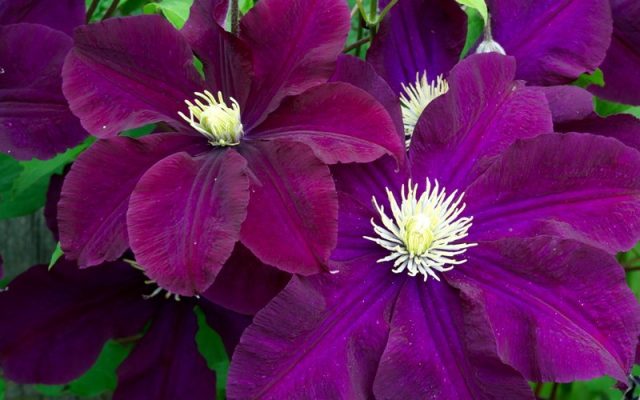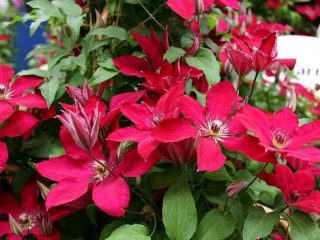Content
Clematis Warsaw Nike is a large-flowered variety of Polish selection, obtained in 1982. The breeder of the variety is Stefan Franczak, a Polish monk who bred more than 70 varieties of the crop. Deciduous vine is used for vertical gardening of the southern parts of the garden in the summer. At the age of 5 years, clematis Warsaw Nike creates a dense, profusely flowering carpet.
Description of clematis Warsaw Nike
Clematis Warsaw Nike is a perennial crop; under favorable conditions it grows in one place for up to 30 years. Climbing vines reach a length of 2-3 m. They grow quickly.
During one warm night, the length of the vine increases by 5-10 cm. During one summer season, Warsaw Nike forms from 1 to 5 shoots.
Clematis Warsaw Nike produces a large number of buds and velvety, large flowers. Young flowers are monochromatic, rich in ripe cherry color. Mature flowers are purple-burgundy, with a light stripe in the middle of each petal. The large stamens of a contrasting light shade give the flowers a special charm.
From the photo and description of clematis Warsaw Nike, it is clear that its flowers last a long time and do not fade in the sun. The largest ones reach 17 cm in diameter. The leaves are leathery, green, obovate.
During the summer period there are two waves of flowering. But due to its duration, the transition becomes imperceptible and it seems that the Warsaw Nike clematis blooms continuously. Flowering begins in June and continues until late autumn. The frost resistance zone of the crop is 4, which means the ability to winter without shelter at -30... -35C.
Clematis pruning group Warsaw Nike
Clematis are divided into 3 pruning groups. Warszawska Nike belongs to the transition group 2-3. The crop can be pruned according to the rules of both groups.
Pruning rules for different groups:
- Group 2 - characterized by weak pruning, which is carried out 2 times. After the first flowering, last year's shoots are pruned in the summer. These shoots are cut off completely. The second pruning is carried out in the fall, after the shoots of the current year have completely flowered, leaving 1-1.5 m of stem length. Immediately after autumn pruning, the plants are covered for the winter;
- Group 3 – severe pruning. In the fall, before going into winter, cut off all shoots, leaving 15-20 cm above the soil.
With both groups of pruning, clematis Warsaw Night blooms equally profusely. Therefore, it is more convenient to cut it and save it according to the rules of the 3rd group.
Optimal growing conditions
Clematis Warsaw Nike is a crop that must be grown in constant, sunny light, but its roots must remain in the shade. When growing, you can’t do without mulching. To protect roots from overheating, weed and pests, it is convenient to use tree trunk circles made of compressed coconut fiber. Also, annual flowers are planted in the foreground for shading.
The roots of Warsaw Nike do not tolerate soil in which moisture stagnates. And the vines must be protected from sharp gusts of wind. A sharply swaying vine can cause mechanical damage to the stems, which can lead to wilting or infection with fungus.
For abundant flowering, the crop needs frequent feeding. To do this, use any fertilizer for flowering plants. Manure can only be applied in rotted form.
The photo of clematis Warsaw Night shows how it climbs high up with the help of thin tendrils. Therefore, it is best to use a thin mesh for support.
Planting and caring for clematis Warsaw Nike
Clematis Warsaw Nike is an early awakening plant. It is best to plant seedlings in October. Seedlings older than 2 years, with a well-developed root system, are planted in open ground. The seedling should have at least 5 roots, their length should be about 50 cm. The young plant should have well-developed vegetative buds.
Selection and preparation of a landing site
To grow clematis Warsaw Nike, choose a permanent place where the crop will grow for many years. Mature bushes do not tolerate transplantation well. Clematis Warsaw Nike is planted on the south side of a fence or building.
The liana is also allowed to grow along specially constructed cones or old trees. You can grow clematis in large tubs. Varshavska Nike variety is resistant to high air temperatures.
Seedling preparation
Before planting, the seedling is stored in the brightest place. But when the buds appear, they are cut off, preventing the plant from blooming. Before planting, the soil in which the seedling grew is spilled with a Fitosporin solution. To relieve stress in a plant during transplantation, it is sprayed with Epin.
Landing rules
To plant clematis Warsaw Nike, make a spacious planting hole, 60 cm in size on all sides and in depth. A layer of drainage is poured onto the bottom. The pit is filled with soil with the addition of compost or well-rotted manure, complete mineral fertilizer and 2 tbsp. ash. Mix everything thoroughly. For planting, a small mound is made at the bottom of the hole on which the seedling is placed.
Deepening the seedling is necessary for the appearance of new roots and the subsequent formation of new shoots. When planting, the roots are straightened, evenly distributed over the soil. During the summer, fertile soil is gradually added until the hole is completely filled.
The description of clematis Warsaw Night indicates that it can be grown next to other varieties of crops. The distance between plants in this case should be 70-100 cm.
Watering and fertilizing
Fertilizing clematis Warsaw Nike is carried out throughout the entire growth period, depending on the amount of growing mass and the general condition of the plant. If the root system was covered with rotted manure for the winter, this fertilizer is sufficient for the entire growth period. In other cases, fertilizing is carried out with fertilizers for flowering plants.
Water the vine once a week, in hot weather and in the southern regions - several times a week. Young plants need about 20 liters of water per watering, adults - about 40 liters. When watering, do not touch the leaf part so as not to spread fungal diseases. It is best for clematis to carry out underground watering.
Mulching and loosening
Loosening enriches the soil with oxygen, enhances the work of microorganisms, which allows the root system to develop better and the plant to increase its vegetative mass. The first surface loosening is carried out in the spring on moist, but not soggy soil. At the same time, remove weeds and cover the soil with a fresh layer of mulch.
Mulching helps maintain soil moisture and looseness. You can use the following as mulch:
- rotted manure;
- humus;
- compost;
- wood chips or leaves.
The layer is applied without touching the shoots, so as not to provoke fungal diseases. When mulching with plant residues, additional nitrogen fertilizers must be added to the soil. Because microorganisms that process such mulch use the nitrogen found in the soil, and the plants will lack this element.
Trimming
Pruning is carried out immediately before the shelter; trimmed clematis should not be left in the open air. The vines are trimmed, leaving one bud. This leads to the awakening in the spring of buds that are closer to the root, which increases the number of new shoots.
Preparing for winter
Clematis Warsaw Nike is frost-resistant. A properly buried plant tolerates the cold season well. When sheltering for the winter, it is important to protect the center of the tillering.Cover clematis in late autumn so that flowering has completely stopped by this time. To do this, in the autumn season it is necessary to pinch the flowering shoots. Before covering, the remaining foliage is torn off the stems, because it may contain fungal spores.
All plant debris and old mulch are removed from under the bush. The shoots and root collar are sprayed with 1% Bordeaux mixture before the soil freezes. Sand with the addition of ash is poured onto the root collar. With any pruning method, the roots of Warsaw Nike are covered with rotted manure or peat for the winter.
The soil for shelter is distributed inside the bush. When pruning, leaving part of the shoots, they are twisted into a ring and pressed to the soil. Spruce branches are laid out on top.
The shelter is additionally covered with non-woven material, leaving a gap at the bottom for air to pass through.
In the spring, the shelter is removed gradually, in parts, until the onset of warm weather. Long shoots are carefully straightened and tied to supports.
Reproduction
For clematis, the vegetative method of propagation is most suitable, when different parts of the plant are used for this.
Clematis Warsaw Nike is propagated:
- Green cuttings. To do this, shoots from an adult plant at the stage of bud formation are cut. For propagation, material is taken from the middle of the vine, with one node present. You can cut no more than a third of one plant. The cuttings are treated with growth stimulants and germinated in containers with a mixture of peat and sand.
- By layering. In autumn, one of the shoots is pressed to the soil and sprinkled. When individual shoots germinate, they are separated and grown.
- Dividing the bush. Plants older than 5-6 years of age are used. In this case, they must be completely dug up and the rhizome divided. Clematis do not tolerate this method of propagation well.
Gardeners practically do not use the method of seed propagation.
Diseases and pests
Clematis Warsaw Nike can be susceptible to various fungal diseases. Throughout the summer, fungicides are used to prevent the occurrence of infections. Soil fungi "Trichoderma" are introduced into the soil - one of the most powerful antagonists of phytopathogens - pathogens of plant diseases.
Common diseases of clematis:
- fusarium and verticillium wilt;
- leaf spot;
- powdery mildew;
- gray rot;
- rust.
In the spring, to protect plants, they are sprayed with a 1% solution of copper or iron sulfate.
Mice and mole crickets can become pests of young shoots of clematis. The vegetative mass is attacked by aphids, spider mites, and various caterpillars. A dangerous parasite for the root system is the root-knot nematode. Insecticides are used to protect against harmful insects.
The appearance of diseases and pests on clematis indicates reduced plant immunity and disturbances in their growing conditions.
Conclusion
Clematis Warsaw Nike is a long-lived vine that increases the number of shoots every year. It has abundant and long-lasting flowering. Large purple flowers attract attention with their tenderness and velvety quality. If you follow simple agricultural practices, you can transform any garden with the help of clematis Warsaw Nike.












